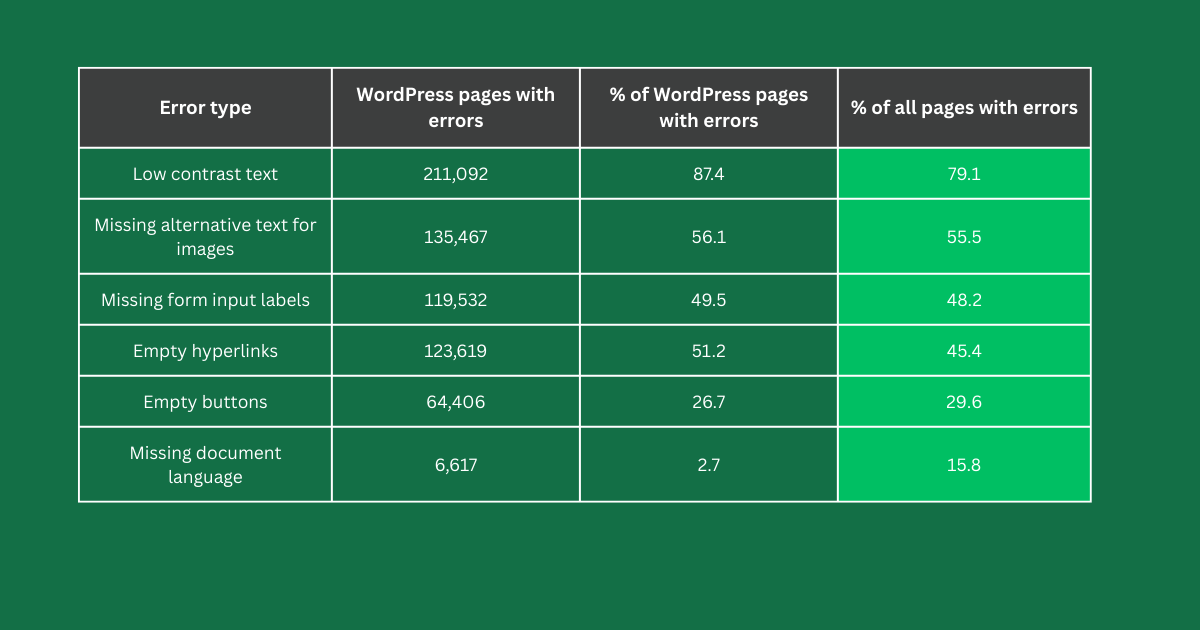
By Chris Winter. June 2025
I have been a fan and advocate of the annual WebAIM Million Report since its first publication in 2019. It reports on the accessibility of the world’s top one million home pages. The report makes for grim reading. As of this year 94.8% of home pages had detectable Web Content Accessibility Guidelines (WCAG) errors compared with 97.8% in 2019. The results in full, together with a description of the methodology and sample websites evaluated, can be found within the report. I believe that these headline numbers are unacceptable and something that the wider IT industry should be embarrassed by.
Digging slightly deeper into the report two things struck me:
- The accessibility of a web page decreases as complexity increases.
- Twenty-four percent of the million pages assessed were built with the WordPress Content Management System (CMS)
Webpage complexity increases accessibility issues
The fact that accessibility decreases as complexity increases is no surprise to me. I have personally advocated for simplicity throughout my lengthy career in IT. I believe that Albert Einstein got it right “Everything should be made as simple as possible, but not simpler.” The specific quote from the WebAIM Million report is “A primary concern is the significant rate of increase in the number of home page elements and ARIA code – both of which correlate to increased accessibility issues. Similarly, the trend of popular JavaScript frameworks and libraries corresponding with higher numbers of errors continues. Home pages are getting larger and more technologically complex at an alarming rate. It seems that if the complexity of home pages could be reined in that the rate of accessibility would increase. We at WebAIM hope that this report will help influence improved accessibility.”
WordPress is used by 24% of million homepages analysed
During my analysis of this year’s report, I noticed that 24% (241,401) of the one million home pages evaluated use the WordPress content management system (CMS). Clearly WordPress is a very popular and is a justifiably successful product. The average number of detected errors for the top million websites is 51 per home page. The average number of detected errors for WordPress home pages is a near identical at 50.
Extract from the WebAIM Million report
Over 1,200 different types of web technologies were detected on the one million home pages. Common technologies detected on more than 5,000 home pages are listed below, ordered from “best” to “worst”. Note that correspondence of additional errors with a technology cannot always be attributed to that technology.
Content management systems and site builders

Additional previously unpublished data courtesy of WebAIM
Further analysis of the data by WebAIM identified that the WordPress error types identified closely mapped to the top six error types detected in million home pages evaluated.

The data indicate that the accessibility of home pages created by WordPress appears to be at odds to the fact that WordPress itself is committed to WCAG conformance and the inclusion of many inbuilt accessibility features in the WordPress product, such as a built-in contrast checker. I do not understand why the WordPress Pages with errors for low contrast text is above average for all pages, could it be user error?
Improvement of the accessibility of web pages created by WordPress would bring significant and positive improvement to the accessibility of the overall web itself. This could be done by improvements to WordPress itself, to its applied usage, or both.
(hypo) It is possible to improve the accessibility of WordPress webpages
I am currently unable to prove this hypothesis. However, I am heartened by the fact that of the 241,401 WordPress home pages 8,672 used the Divi product. The average number of detected errors per Divi home page was 27.6 vs the WordPress average of 50.0. However, not all third-party products improve accessibility, as is the case with wpBakery with an average number of accessibility errors of 63.5 being detected in 17,576 home pages.
I will continue my research into my hypothesis and will publish my findings in future blogs.
Chris’s previous blogs for AIT:
- Beware of missing Accessibility Statements on websites
- Raising awareness with organisations about digital poverty and accessibility.
- Making the World Wide Web more Accessible
- Low colour contrast makes websites illegible
- The IT Industry has standards and guidelines dating back a quarter of a century.
- (ESG) the potential silver bullet that I have been searching for to make a step change to the accessibility of digital services.
- A summary of the story so far, as told in parts 1 – 6. ?https://archivesit.org.uk/blog/the-it-industry-must-do-more-for-disabled-people-part-seven/
- Awareness is a lifetime experience. ?https://archivesit.org.uk/blog-2/the-it-industry-must-do-more-for-disabled-part-8/
- Legislation and regulation are required to improve digital accessibility, but there are significant benefits to be gained from self-regulation. ?https://archivesit.org.uk/blog/the-it-industry-can-do-more-for-disabled-people-part-nine/
- The Valuable 500 white paper on Environmental Social and Governance (ESG) and Disability Data and says that all organisations should include W3C Web Content Accessibility Content within their Environment Social and Governance (ESG) programmes.
https://archivesit.org.uk/blog/ - Given there is digital accessibility legislation and regulation I ask why it isn’t always implemented.
https://archivesit.org.uk/blog-2/the-it-industry-can-do-more-for-the-disabled-part-11/ - https://archivesit.org.uk/blog/the-it-industry-must-do-more-for-disabled-people/
About the author
Chris Winter FIET FBCS CITP is an Advocate for the Digital Poverty Alliance, an evangelist for digital accessibility and a former IBM Fellow, now retired.
About the Digital Poverty Alliance (DPA)
The DPA defines Digital Poverty with five key determinants: the affordability of devices and connectivity, accessibility (for the disabled), skills, motivation and a lack of ongoing support. With the breadth of digital poverty being so broad. Its objective is to eradicate digital poverty in the UK by 2030.